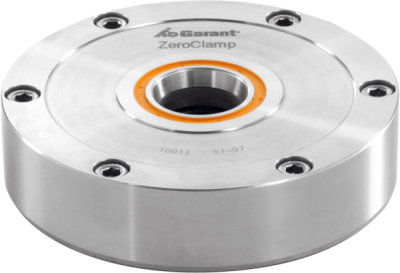
Hoffmann Group knows that with the growing complexity of production and the increased diversity of components, new challenges in the production process arise for customers. Available from Hoffmann Group USA is the GARANT ZeroClamp system, a highly accurate clamping system for the metalworking industry.
The GARANT ZeroClamp was launched on to the market 7 years ago and has now become well established. Satisfied customers already have more than 55,000 clamping pots in use, each saving hard cash. Due to its highly flexible and unlimited capability for applications, this clamping system scores highly among customers. The ZeroClamp system is suitable for all types of machines because it can quickly and individually configure for all applications.
Due to its hollow-shank taper principle, when retracting the clamping bolt, the elastic part of the taper ring of the chuck slightly expands, thus providing a highly accurate fit, with repeatability of less than 3 microns. If the measurement process shows the component needs further machining, the component can be positioned on the machine quickly and precisely with high repetition accuracy – be it for call batch or a one-off item.
Unlike other systems that have many bolt sizes, the ZeroClamp system only requires one type of clamping bolt. Thermal symmetry is provided at all times through its central zero point, important for workpieces that rotate around a central axis. The ZeroClamp system guarantees repetition accuracy, providing clean clamping points and efficient production.
Long setup times area thing of the past. The GARANT ZeroClamp zero point clamping system increases productivity in manufacturing. Be it milling, turning, spark erosion, measurement, grinding or presetting – the latest clamping technology provides applications in all situations and suitable for a wide range of special jobs.
Contact Details
Related Glossary Terms
- chuck
chuck
Workholding device that affixes to a mill, lathe or drill-press spindle. It holds a tool or workpiece by one end, allowing it to be rotated. May also be fitted to the machine table to hold a workpiece. Two or more adjustable jaws actually hold the tool or part. May be actuated manually, pneumatically, hydraulically or electrically. See collet.
- gang cutting ( milling)
gang cutting ( milling)
Machining with several cutters mounted on a single arbor, generally for simultaneous cutting.
- grinding
grinding
Machining operation in which material is removed from the workpiece by a powered abrasive wheel, stone, belt, paste, sheet, compound, slurry, etc. Takes various forms: surface grinding (creates flat and/or squared surfaces); cylindrical grinding (for external cylindrical and tapered shapes, fillets, undercuts, etc.); centerless grinding; chamfering; thread and form grinding; tool and cutter grinding; offhand grinding; lapping and polishing (grinding with extremely fine grits to create ultrasmooth surfaces); honing; and disc grinding.
- metalworking
metalworking
Any manufacturing process in which metal is processed or machined such that the workpiece is given a new shape. Broadly defined, the term includes processes such as design and layout, heat-treating, material handling and inspection.
- milling
milling
Machining operation in which metal or other material is removed by applying power to a rotating cutter. In vertical milling, the cutting tool is mounted vertically on the spindle. In horizontal milling, the cutting tool is mounted horizontally, either directly on the spindle or on an arbor. Horizontal milling is further broken down into conventional milling, where the cutter rotates opposite the direction of feed, or “up” into the workpiece; and climb milling, where the cutter rotates in the direction of feed, or “down” into the workpiece. Milling operations include plane or surface milling, endmilling, facemilling, angle milling, form milling and profiling.
- turning
turning
Workpiece is held in a chuck, mounted on a face plate or secured between centers and rotated while a cutting tool, normally a single-point tool, is fed into it along its periphery or across its end or face. Takes the form of straight turning (cutting along the periphery of the workpiece); taper turning (creating a taper); step turning (turning different-size diameters on the same work); chamfering (beveling an edge or shoulder); facing (cutting on an end); turning threads (usually external but can be internal); roughing (high-volume metal removal); and finishing (final light cuts). Performed on lathes, turning centers, chucking machines, automatic screw machines and similar machines.
